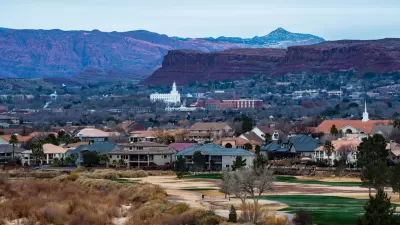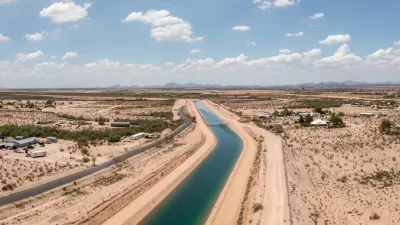New communities are popping up across Arizona’s desert, evading water consumption restrictions and straining the state’s groundwater supplies.

Reporting for KJZZ, Katherine Davis-Young examines Arizona’s increasingly urgent water crisis. As Davis-Young explains, “Maricopa County’s population has more than doubled over the past 30 years, making it one of the fastest growing regions in the country. But meanwhile, Arizona’s water supply has become more and more depleted.”
The 1980 Groundwater Management Act called on the state to use underground aquifers primarily as a back-up and employ tactics to replenish groundwater supplies, but Kathleen Ferris, a researcher from Arizona State University, says that has not been happening.
“In most areas of central Arizona, a developer can’t build a new home without first proving that there’s enough water to last that property 100 years. But there are loopholes for larger lots in rural areas, like many homes in Rio Verde Foothills.” And while some cities like Phoenix have actually reduced their water use even as their population grew, rapid development happening in undeveloped desert areas largely counts on groundwater. “Back in 1980, legislators set a target to achieve safe yield of groundwater by 2025. So Ferris thinks the time for elected leaders to start answering questions about growth and sustainability is now.”
More Planetizen coverage of the water crisis in the American West:
FULL STORY: Arizona's water supply is shrinking, but its population is growing. Is it sustainable?

Planetizen Federal Action Tracker
A weekly monitor of how Trump’s orders and actions are impacting planners and planning in America.

San Francisco's School District Spent $105M To Build Affordable Housing for Teachers — And That's Just the Beginning
SFUSD joins a growing list of school districts using their land holdings to address housing affordability challenges faced by their own employees.

The Tiny, Adorable $7,000 Car Turning Japan Onto EVs
The single seat Mibot charges from a regular plug as quickly as an iPad, and is about half the price of an average EV.

Seattle's Plan for Adopting Driverless Cars
Equity, safety, accessibility and affordability are front of mind as the city prepares for robotaxis and other autonomous vehicles.

As Trump Phases Out FEMA, Is It Time to Flee the Floodplains?
With less federal funding available for disaster relief efforts, the need to relocate at-risk communities is more urgent than ever.

With Protected Lanes, 460% More People Commute by Bike
For those needing more ammo, more data proving what we already knew is here.
Urban Design for Planners 1: Software Tools
This six-course series explores essential urban design concepts using open source software and equips planners with the tools they need to participate fully in the urban design process.
Planning for Universal Design
Learn the tools for implementing Universal Design in planning regulations.
Smith Gee Studio
City of Charlotte
City of Camden Redevelopment Agency
City of Astoria
Transportation Research & Education Center (TREC) at Portland State University
US High Speed Rail Association
City of Camden Redevelopment Agency
Municipality of Princeton (NJ)





























